Newsletter
Current
Previous
|
September 2013
|
|
|
|
|
 The Culling of Badgers Where to start? Relevant information would fill several large volumes. The very thought of a cull generates battle lines, drawn with no quarter given between supporters of this much-loved wild animal and farmers desperate to protect their cattle. 5000 are due to be killed in two pilot culls in West Gloucester and West Somerset, where the disease is prevalent. The Culling of Badgers Where to start? Relevant information would fill several large volumes. The very thought of a cull generates battle lines, drawn with no quarter given between supporters of this much-loved wild animal and farmers desperate to protect their cattle. 5000 are due to be killed in two pilot culls in West Gloucester and West Somerset, where the disease is prevalent.
The European badger (meles meles), 'Brock' or 'Grey', is featured in much of our literature. Unseen by the majority of us except dead on the roadside, it somehow elicits affection. Farmers are understandably not so well disposed, insisting Brock transmits bovine TB to their cattle. The argument about this transmission, and how to stop the march of bovine TB, has raged for years.
The farmers say 'cull', but a great many scientists don't agree this is the answer. Other solutions put forward have been vaccination of badgers and of cattle, curbing the trading and movement of cattle, some of which are possibly infected so spreading it to clean areas, and contraceptive treatment of badgers to reduce the population. David Cameron is in favour of culling, citing the further billion pounds in compensation to the farmers, which will be paid over the next ten years.
Easy to say 'cull', but what are the practicalities? Gas down the setts? Shooting of free-running badgers? The marksmen selected to carry out the cull will need to be super accurate shots! Perhaps the cost of possible full-scale culling would be better spent on finding a more humane way of solving this gigantic problem.
The above will probably have been overtaken by events when you read this. Find out more by attending the talk on Monday, September 16, 19.30 to 21.30, 'The resurgence of bovine TB in England and Wales: a scientific and political conundrum' by Nick Taylor, a veterinary epidemiologist working at the University of Reading.
Another talk of interest is by Ray Reedman on 18th November on An Exploration of Bird Names. Giving names to animals and plants is quite a tricky business (see page 2). I'd hazard a guess most readers don't know what Vachellia erioloba is. Well, come along to the talk on ANTS on 21st October and find out.
|
|
|
| 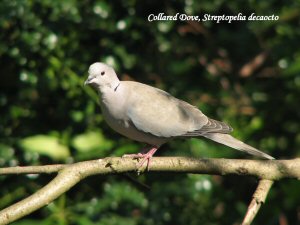 The Eighteen Bird turns sixty The Eighteen Bird turns sixty
One of the regulars in my garden - and many others, of course - is the beautiful little Collared Dove, Streptopelia decaocto. Only those of a certain vintage will remember Britain without them, so many may not realise that this year is the sixtieth anniversary of their first appearance in Britain. This was not an expansion related to climate change, but rather to a generally unexplained expansion of the population westwards from Asia. When they were first named and described by a Hungarian, Frivadlsky, in 1838, they had reached Greece, and by 1940 had crossed the Balkans. Progress towards the English Channel was more rapid over the next decade or so, and I well remember that news of their arrival was the avian sensation of my teens.
The scientific name for the genus, Streptopelia, derives from Greek words meaning "collar/necklace" and "dove", since birds of the genus have distinctive neck markings, in this case a neat black flash. But it is the species name which is most interesting, since decaocto means "eighteen". But why eighteen? According to James Fisher, in an article in British Birds in May 1953, a legend was told by C. Hinke to J.F. Naumann in 1837, which goes thus:
"A poor maid was servant to a hard-hearted mistress, who gave her as wages no more than eighteen pieces a year. The maid prayed to the Gods that she would like it to be known to the world how miserably she was paid by her mistress. Thereupon, Zeus created this Dove, which proclaims an audible deca-octo to all the world to this very day."
Fisher quite rightly points out that the four syllables of the name fit badly with the repetitive three-syllable song, so I surmise that there was possibly a local shortening of the second vowel to dec'octo to allow the tale to work.
The arrival and success of this species has nothing to do with the decline in recent years of its cousin, the Turtle Dove. That bird risks migration every year, and suffers both here and in Africa from habitat degradation. The Collared Dove is resident and apparently here to stay, a wonderful addition to our bird-life. So, if the song drives you to distraction, count to eighteen, and then to sixty, while you contemplate the value of a true winner.
Ray Reedman, June 2013
See Forthcoming Events for details of Ray's talk on 'An Exploration of Bird Names' on November 18th.
|
|
|
On the subject of bees:
Welsh Poppy: To Be (Meconopsis), or not to be, that is the question
|
|
We are constantly urged to plant wild flowers in our gardens. I can't praise the Welsh poppy enough. Although this is designated wild, it sits well in a garden situation. I can guarantee that every morning in late spring/early summer, you will hear the loud buzz of bees on the yellow and orange flowers. The loud buzz is a cunning ploy to free up the pollen. It's very interesting to see a bee's-eye view of this dainty flower.
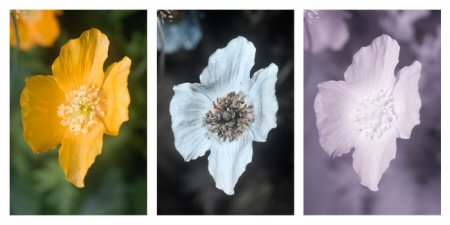 Photos by kind permission of Dave Kennard In ultraviolet (middle), the anthers and stigma appear much darker than they do in visible light. There are also UV markings at the base of the petals. These are nectar guides, and are thought to help bees and other insects that can see ultraviolet light home in on the area of the flower where nectar and pollen are located. In infrared light (right), the poppy appears much the same (in terms of tone) as it does under visible light.
It's an ideal plant to brighten up a shady corner in a garden, although it self-seeds over much of my garden. One piece of research referred to it disdainfully as aposa weed'. How very disrespectful! Originally assigned by Linnaeus with the other poppies to the genus Papaver, it then became Meconopsis cambrica. Recent DNA research suggests that Linnaeus was right, and it's closer to the genus Papaver. To finish with the Bard, 'What's in a name? that which we call a rose by any other name would smell as sweet'. (For 'rose', substitute Meconopsis cambrica, and I'm afraid it doesn't have a smell).
|
|
In praise of garden flowers: I took a long hard look at my garden and on a sunny Aug 7th, contrary to Monty Don's opinion on dahlias, one of the most popular drop-in cafes for bumble bees of varying sizes and colours was my dahlia of unknown name.
Sheila
|
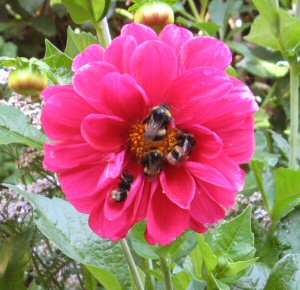
|
|
|
EEG member Anne Booth attended a right, royal 'do' recently.
Plantlife - speaking up for wild plants
| Plantlife began in 1989, following a conference of leading conservation organisations, where the case was argued that not enough was being done to protect and conserve wild plants. Since then Plantlife has grown from an office of two people to a staff of 40 with a head office in Salisbury, and national offices in Wales and Scotland. It has 23 nature reserves across the UK, covering more than 4,500 acres (1,800 hectares) in total.
Plantlife actively campaigns on a number of issues affecting our wild plants and fungi. It takes positions on important matters that impact on wild plants and their habitats both in the UK and globally such as ash die-back, juniper decline, sowing seed in the wild, peat, invasive species, road verges and climate change. It provides reports and recommendations to inform policymakers and the public at large on the botanical and environmental implications often embedded in important public policy issues.
Their patron is HRH the Prince of Wales and in 2012 he suggested a remarkable project: a meadow in every county to mark the anniversary of the Queen's coronation. These 'Coronation Meadows' would be outstanding examples of flower-rich grasslands, surviving fragments that support our wildlife.
Sites have now been identified in nearly every county in Britain - many have an annual hay cut and are grazed by hardy, native breeds of livestock and reflect the local character of the landscape. Now the second part of HRH's original vision, to collect green hay and seed from them to restore or recreate new meadows, can begin.
The final part of the project is perhaps the most ambitious - to map the UK's remaining meadows. No such inventory currently exists but, with the help of the public, Plantlife hopes to identify all the small pockets of flower-rich meadows that remain.
Berkshire's Coronation Meadow is the network of connecting fields at the BBOWT reserve at Moor Copse. In June I was asked to represent Berkshire at the launch of the project at Highgrove House, where I joined other volunteers and staff from all over the UK who were there representing their own County sites. Anne Booth, voluntary Reserve Warden, Moor Copse
Useful addresses www.plantlife.org.uk www.moorcopse.org.uk www.bbowt.org.uk
|
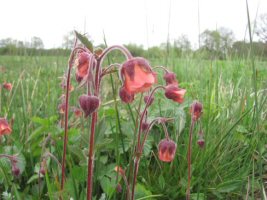 Beautiful water avens in Moor Copse |
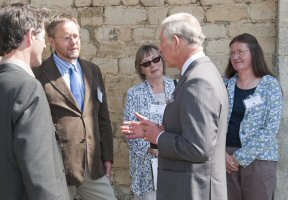 Anne Booth (right) waiting to have her say
(Photograph by Robin Bell
for the Coronation Meadows Project) |
|
| The Plight of Our Bees
It's a well-known fact that our bees are having a hard time of it for a plethora of reasons. They need our help. Friends of the Earth's campaign, "The Bee Cause", is highlighting this unhappy state, and would like people to sign up to their petition addressed to David Cameron, urging the government to create a Bee Action Plan for the whole of the UK to reverse the decline in Britain's honey bees and wild bees. It is hoped that all interested parties will be able to contribute to such planning, and not just DEFRA. A government report is awaited with interest later in the year.
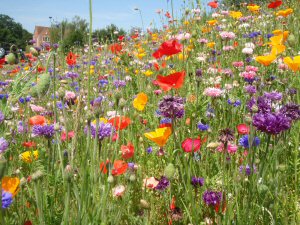 LOCALLY: LOCALLY:
Earley Town Council has planted several wildflower sites, specifically to attract and provide a lifeline for our native pollinators, as well as supporting butterflies. The photo shows the beautiful wildflower meadow created by ETC in Paddick Drive.
Reading University is a major centre for Bee research, and produced the report, 'The Decline of England's Bees'.
Reading Borough Council has provided sites to be planted up for the Urban Pollinators@ Research Project.
The Museum of English Rural Life (MERL) has planted flowers for bees.
Websites: Friends of the Earth Pushing up Dandelions (a journey into allotmenteering).
Reading: "A World Without Bees", Alison Benjamin and Brian McCallum, pub. Guardian Books.
|
|
THE ANNUAL EARLEY GREEN FAIR
Earley Green Fair, held on August 3rd, was the usual great success, and brought hundreds of visitors to the Maiden Erlegh Local Nature Reserve. It has been organised or the past eight years by Earley Town Council park ranger Grahame Hawker, who said the feedback had been fantastic and 20 people had already signed up for 2014. The fair is a showcase for the area's wildlife, conservation and environmental groups. Among the many stalls were representatives from Earley Environmental Group, the Wokingham District Veteran Tree Association, Reading Friends of the Earth, Mid-Berks Ramblers and The Wildlife Trust.
Photo: John Booth and Michael Brice on the Friends of the Earth stand, publicising the FoE Cause for Bees.
|
|
|
The 2013 BUG HUNT
This year's Bug Hunt was the usual happy event. Seventeen children took part, led by expert bug hunter Alan, chairman of the EEG. This involves a lot of organisation on his part, collecting microscopes and other necessary equipment like sweep nets, and setting up a moth-trap the night before.
After an introductory talk, the children made their way to a wild part of the Maiden Erlegh Nature Reserve and had a great time with the sweep nets. Anything captured was then taken to the Interpretation Centre to have a much closer look, with Alan giving detailed information on what could be seen under magnification. At the end of their investigations, the children went outside to see the release of the moths which had been captured in the trap, always a cause for excitement on seeing the moths take wing.
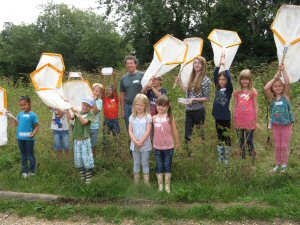
The following children took part: Charlotte and Honor Maskell, Owen West, Alex Jaeger, Eve and Grace Whitley, Rajan and Ameya Dhanjal, James and Emma Johnson, Dylan and Lily-Mai Stenson, Charlie and Jacob Prince, Ewan and Lauren Britland, and Nasser Rashid (the big kid in green is Alan). See theWokingham Times for more pictures.
|
|
SIBLY HALL DEVELOPMENT
Earley Town Council has recommended refusal of an application by Persimmon Homes to develop the site. At the meeting on July 16th, councillors were concerned by the change in layout from that set out in the outline application. In brief, it was considered that the proposal was of poor design, and did not make best use of the site. There was an increase in the number of bedrooms, for which the amount of parking seemed insufficient. Members of the public present thought that the proposed linkages into Somerton Gardens were not in the best interests of crime prevention. ETC will make a formal request to WBC that the application be discussed by Wokingham's planning committee.
The plan application number is RM/2013/1232. For a fuller account of the ETC meeting, see page 4 of the minutes of the Planning Committee for 16th July.
Anne Booth
|
RECYCLING NEWS

Ice-cream, margarine and yoghurt tubs can now be binned for recycling not only around the University, but also at Sainsbury's, Winnersh (in the main area of the car park at the back). This collection is not by WBC.
|
|
|
NEWS FROM BEYOND EARLEY
THE BRITISH TIGER: We all know the desperate state of the world tiger population, but spare a thought for the 'British Tiger'. Wildcats have been in the British Isles for hundreds of years, but are now thought to be down to the last few hundred, although this is probably an over-estimate. One scientist has warned that pure Scottish wildcats could be extinct within two years, and the wildcat is now one of the rarest animals in the world. In the past they could be found in many counties of the UK, but the advent of game-keeping, loss of habitat and interbreeding with domestic cats have done for them. A new Wildcat Trust charity is being formed, so look for future news of it.
|
EARLEY WILDLIFE SIGHTINGS and NEWS
Gillian: July Butterflies have made welcome visits to Gillian's garden, aided by the recent timely warm weather. These included the comma, holly blue, peacock, red admiral, speckled wood, small white, and gatekeeper.
Birds were the usual garden visitors, but included 11 starlings* on the back lawn and green woodpecker in the front garden.
*11 seems a good number, with RSPB surveys showing an average of 3 per garden last year compared to 15 in 1979. It doesn't pay to take any wildlife for granted. The RSPB also warned that the numbers seen in the murmurations, when the birds gather above roost sites at dusk and fly in patterns before settling down for the night, are also dropping.
It is not clear what is causing the declines, although possible causes include changes to and reductions in their insect food because of drought and farming methods.
In Berkshire the most recent high count of 10,000 was at Brimpton in 2004, prior to that 12,000 at Thatcham in 2000. This compares with counts of "millions" in the 1950s.
|
LOCAL FORTHCOMING EVENTS 2013
Monday, September 16 19.30 to 21.30 The resurgence of bovine TB in England and Wales: a scientific and political conundrum - Nick Taylor, a veterinary epidemiologist working at the University of Reading. Venue: Function Room, Maiden Place, off Kilnsea Drive, Lower Earley
Monday, 21st October 19.30 to 21.30: Ants A talk by Heather Campbell. Heather has undertaken extensive research into thorn-dwelling ants in Namibia. Ants don't often figure high on a list of favourite insects, but you may think again after Heather provides a picture of these fascinating insects, and their association with the camelthorn tree, Vachellia erioloba. Come and be prepared to be surprised. Venue: Function Room, Maiden Place, off Kilnsea Drive, Lower Earley.
Monday, 18th November 19.30 to 21.30: An Exploration of Bird Names - A talk by Ray Reedman. What do the following have in common? An Indian prince; a Victorian postman; a Little Brown Job; a bit of dubious Anglo-Saxon; a lack of feet; the Cree people; a fear of horses; King Canute? The answer is that they, and many more surprises, all appear in the story of the names of British birds, which will be told in An Exploration of Bird Names. Venue: Function Room, Maiden Place, off Kilnsea Drive, Lower Earley.
December: Christmas Social, see the website for full details.
2014
Tuesday, 21st January 19.30 to 21.30: Annual General Meeting of the Environmental Group and a follow-up to the Plants on Walls that Kit Brownlee did this past year. She will tell us about the creatures that we can find on the walls around us. Venue: Function Room Maiden Place, off Kilnsea Drive, Lower Earley.
|
|
Bits and pieces
You might like to make a note of the Reading Town Meal 2013, Forbury Gardens Saturday 5th October 12noon to 4pm. The biggest "picnic in the park" that Reading has ever seen will return to Forbury Gardens on Saturday 5 October and we want the local community to get involved in this celebration of local sustainable food. A delicious meal, cooked by Reading College catering students from produce grown and donated by local allotment holders and home growers will be served free to over 1,000 people. Forbury Gardens will be filled with fun activities, cookery demonstrations and local food producers. Community groups will be setting out their stalls and music from local bands will keep the tempo going all afternoon.
BBOWT:Berks Mammal Group meeting 17th October 19.00-21.00. Hugh Warwick Talk. BMG Social members free, non-members £2. Hugh has been invited back to talk about his latest book, The Beauty in the Beast. This is going to be a fun and exciting start to the season of indoor meetings. Venue: the Reading International Solidarity Centre. After the presentation there will be a group social downstairs in the Global Café. Contact: Edwin Trout. To find out more about Hugh, the hedgehog-loving ecologist, why not visit his blog?
Living Record is designed to encourage people to record the wildlife they see around them by making the process quick and easy. It provides a personal record system for each participant and shared distribution maps to inform and inspire. Find out more here. Also check out our March 2012 newsletter.
EASI (Earley Adopt-a-Street Initiative) would like more volunteers. Help keep your street clear of litter. Everything provided. Phone Brian Hackett on 0118 986 1115 or email
Can you offer active help to EEG? If so, phone 0118 962 0004 or go to the website. If so, phone 0118 962 0004 or go to the website. We would welcome more member involvement. If you have no expertise and would like to get involved, you may be able to give practical help. Perhaps you could distribute some of the newsletter hard copies, or maybe you have graphic design skills (for occasional posters, leaflets), computer skills, any other skills to offer.
Join the EEG Yahoo Group and post your sightings and messages. You’ll find a link to Yahoo on our website.
EEG committee members can be found on www.earleyenvironmentalgroup.co.uk under Contacts, or phone 0118 962 0004
For Wildlife Survey Forms, go to the website or phone Earley Town Council on 0118 986 8995
Comments or contributions to the newsletter to: the Editor or 2 Reeds Avenue, Earley, RG6 5SR. We would welcome short contributions from members to the newsletter.
If you know anyone who would like to join EEG, membership forms are available from Earley Town Council, 0118 986 8995, on the website under Downloads , or send an e-mail to the Membership Secretary. Please inform Liz if you intend to change e-mail or address at 50 Kenton Rd, Earley RG6 7LG, or send her an e-mail.
|
SUPPORT YOUR LOCAL SHOPS
The True Food Co-op: Their mission is to take low-cost organic food out to the people, bypassing the supermarkets which charge a lot for organics. Although the Silverdale Market is closed, you can shop at Lower Earley Market, Trinity Church, Chalfont Close, Earley RG6 5HZ (next to Asda store), Saturdays 12 noon to 3pm.
Pet Fayre 9 Maiden Lane Centre Lower Earley : A small independent shop, with bird feeders of all kinds, a variety of bird feed, large bags of which the shop is willing to deliver locally, tel. 0118 9266512, e-mail or go on the comprehensive website
|
|
|
Thanks to ORACLE Corporation for reproducing our newsletter on recycled paper. Oracle is the world's second largest software company, situated at Thames Valley Business Park in Earley. Oracle UK adheres to the ISO14001 Environment Standard which confirms Oracle has considered and acted upon its environmental impact. As part of Oracle’s corporate social responsibility they support a number of local groups, including us. They have given us valuable support in reproducing the hard copies of our newsletter in colour, as well as printing posters and membership leaflets for us to distribute to libraries, schools etc. |
|